This blog is dedicated to hunting edible wild mushroom in Mid-Missouri. I am by no means an expert, so these ramblings and musings reflect my opinions based on a lot of research and experience. I cannot stress enough, always be certain that you have properly identified any mushroom before eating it. Remember when in doubt throw it out.
Monday, September 24, 2007
A comment was recently made requesting information about preparing Boletes and it made me realize that I should say a little more about the subject of eating Boletes and other wild mushrooms in general. I cannot stress enough the importance of being 100% certain of your identification before eating any mushroom. And even when certain, when trying a mushroom for the first time, I recommend only eating a very small portion at first to see if you have any allergies or adverse reactions. Even some common edibles (morels included) have been known to adversely effect some people.
I personally have little experience in identifying Boletes, so I do not trust myself well enough to eat any of them. Since I do not eat them, I am sorry but I do not know a very good way to prepare them. There are a few recipes on The Morel Board (free registration required) at http://www.michiganmorels.com/forums/search.php?s=&action=showresults&searchid=85771&sortby=lastpost&sortorder=descending
Dr. Kuo, the person who runs MushroomExpert.com use to contain a good general list of rules for eating boletes; though now he has this in its place:
http://mushroomexpert.com/edibility.html (which highlights how easy misidentification can be).
I managed to archive a copy of his rules and have listed them below.
Edibility Rules for Boletes
by Michael Kuo
(The rules for eating boletes will only help you if you're sure you know what a "bolete" is; please study the keys and their accompanying texts, especially the Key to Boletes, if you are unsure. Please also read our Disclaimer.)
The boletes form a relatively safe (and decidedly tasty!) group of mushrooms, as far as edibility is concerned. However, some poisonous species exist, and a few fatalities resulting from boletes are on record. The rules below reflect what is currently known about boletes--but there is, of course, always the possibility that you may find a mushroom that is uncharacteristic or simply unknown. Always experiment with new species by eating only a bite or two the first time, and waiting 48 hours before continuing!
If you have some experience with boletes, you will notice that the rules wind up excluding some good edibles (Boletus bicolor, for example). But they will also exclude all the boletes known to be poisonous--and by the time a mushroom collector can distinguish Boletus bicolor from the poisonous Boletus miniato-olivaceus, she will be identifying mushrooms to species with enough confidence to consult edibility reports for individual mushrooms.
1. Eat Only Fresh, Young Specimens
There are two reasons for this. First, you will eliminate the possibility of simple food poisoning resulting from the consumption of rotting food (and you will avoid eating some nasty critters that tend to inhabit older specimens). Second, this will force you to consider only specimens whose macrofeatures are still easily recognizable. Pore surfaces of some boletes can eventually become brownish or blackish, regardless of the colors they manifested their prime--and bruising or staining reactions are no longer trustworthy with old mushrooms.
2. Avoid Boletes with Red or Orange Pore Surfaces
The currently documented most-poisonous boletes, like Boletus satanas, have red or orange pore surfaces, like the mushroom in the illustration (see the top arrow). Do not eat any bolete whose pore surface is red or orange, or some version of these colors.
3. Avoid Boletes That Stain or Bruise Blue to Green
Admittedly, this rule eliminates nearly half of all boletes. But it also eliminates all the boletes, besides the red- and orange-pored species, known to be poisonous, or for which edibility is suspect--particularly those in the Fraterni constellation. In the illustration, the bottom arrow indicates the flesh of a bolete turning blue on exposure to air. Also check for blue bruising by teasing the cap, stem, and (especially) the pore surface with the flat side of a knife.
4. Avoid Orange-Capped Leccinum Species
Leccinum includes some very good edibles, but the record is becoming more and more clear: some people are adversely affected by some of the orange-capped species. Marilyn Shaw has documented this in Colorado (see Bessette, 2000, 374), and some field guides will mention the possibility. I know from personal experience; I am one of the "some people" adversely affected--and I can tell you that the poisoning is not at all how you want to spend one or two days of your life!
There are many Leccinum mushrooms with orange caps. But since Leccinum species are notoriously difficult to separate, even for experts, you should avoid any orange-capped species. If you are not sure you can distinguish Leccinum species from other boletes, you should change this rule and not eat any boletes with orange or orangeish caps.
© 2000-2005, MushroomExpert.Com
Friday, September 21, 2007
Still haven't receive enough rain to get anything in most of the woods around Columbia going, at least not in my usual spots. The fall season is looking good up north as Michigan has had plenty of rain and some long cool nights to get the honeys, hen of the woods and chickens flushing. I hope we get some rain soon or the fall season will be a bust just like last year.
At least I had some nice fried morels with breakfast this morning. They were delicious and tasted fresh like I had just picked them this morning. A delightful reminder of last season's fortune. See my post from April (Eating Morels in December - How to Preserve Your Bounty) for more details on how they were prepared. Whenever I eat some I always think ahead to next spring . They are so fickle a fungi, that even a seasoned hunter wonders will they be there next year.
Wednesday, August 15, 2007
Sunday, July 15, 2007
Lots of mushrooms out right now but they are drying up in the heat if you aren't lucky enough to catch an afternoon thunderstorm. Here is a nice 3 pound chicken I found this week.
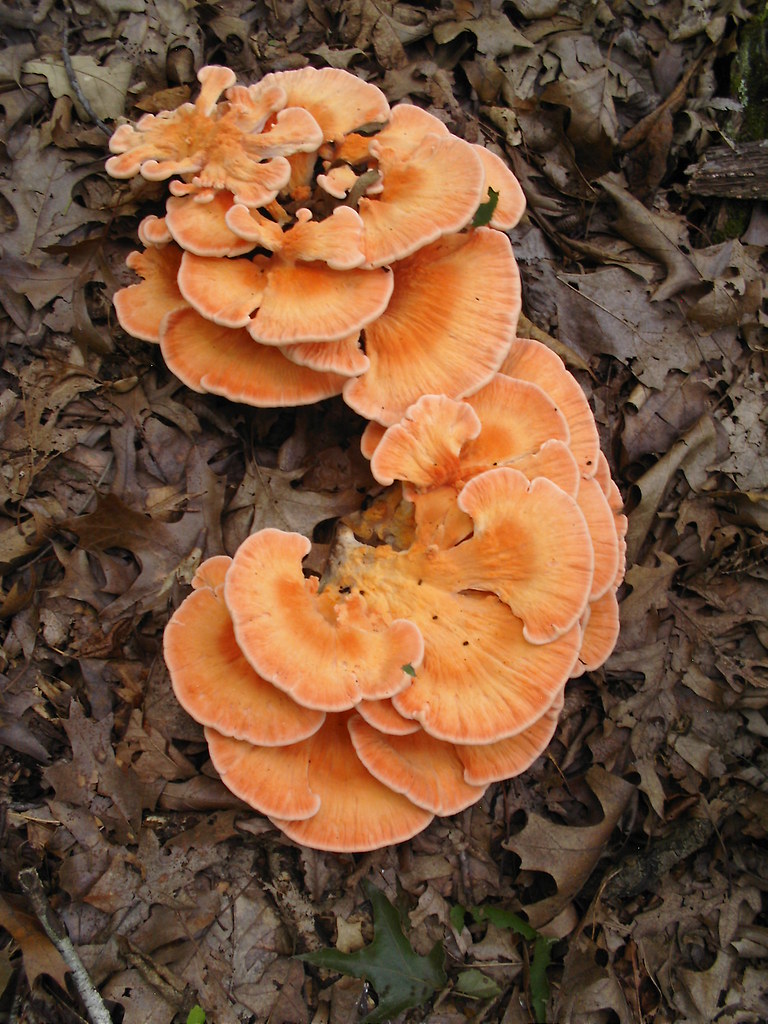
Here is a close up. This was a the white-pored variety.
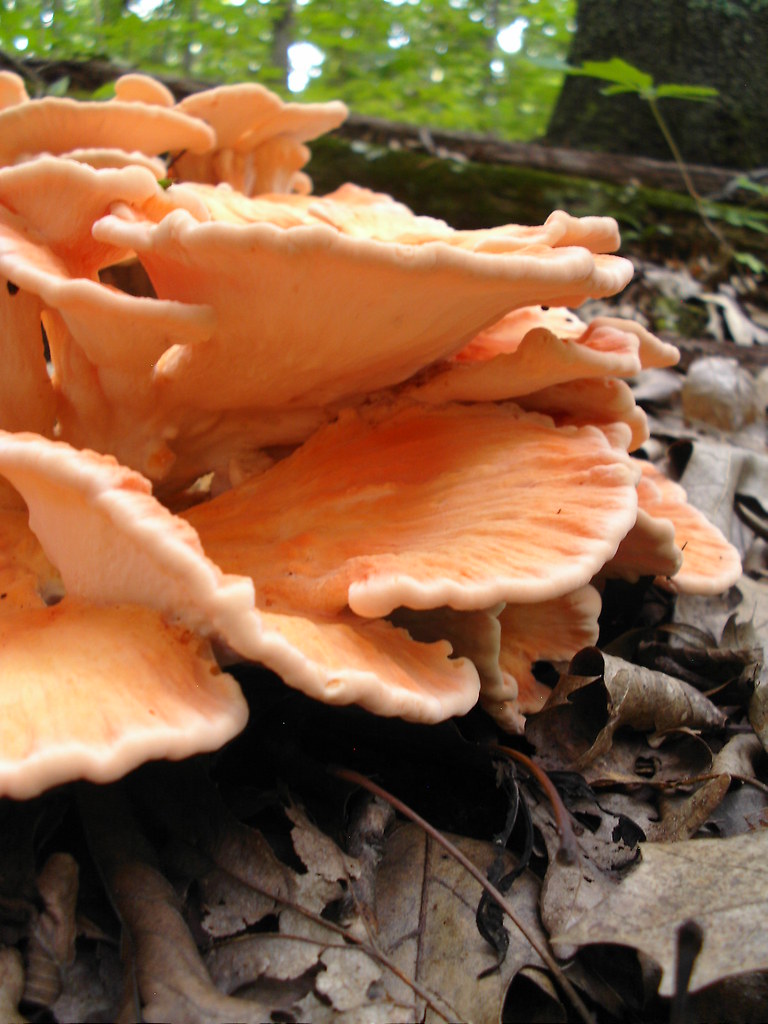 This was the starting edge of a good patch of smooth chants. I picked about 150 from this patch alone. Some were over 6 inches across.
This was the starting edge of a good patch of smooth chants. I picked about 150 from this patch alone. Some were over 6 inches across.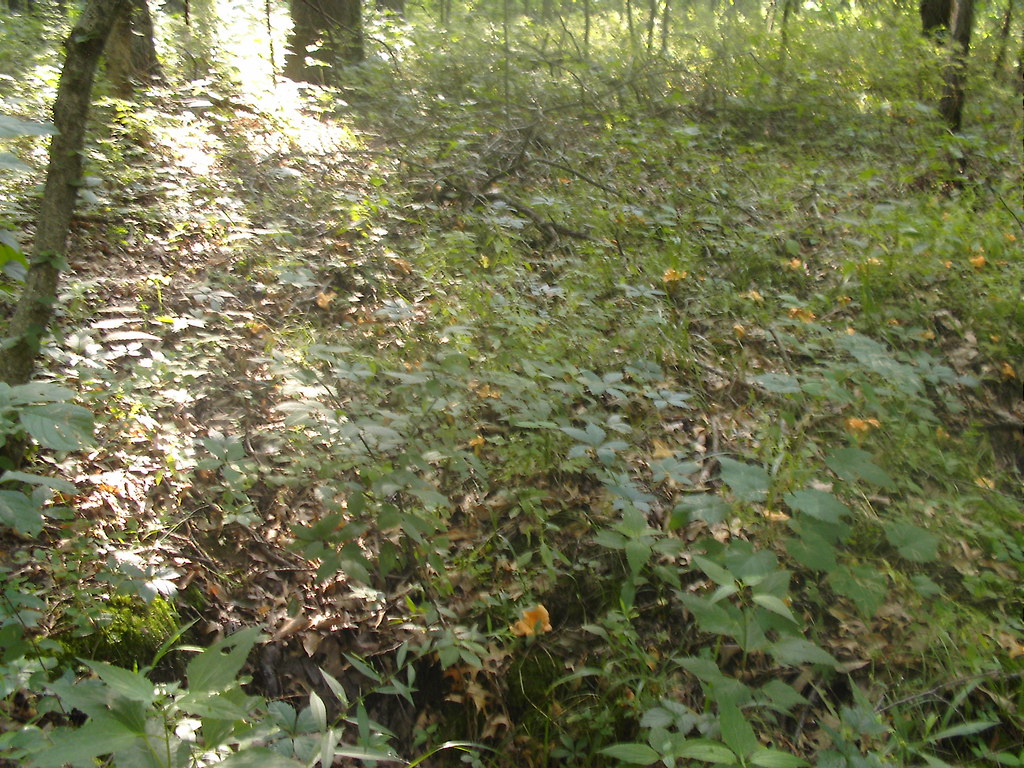
Here is an easily recognizable bolete, the Old Man of the Woods. This old one was hiding under an earthen shelf along a runoff creek. This is edible, though many stay away from this old hermit.
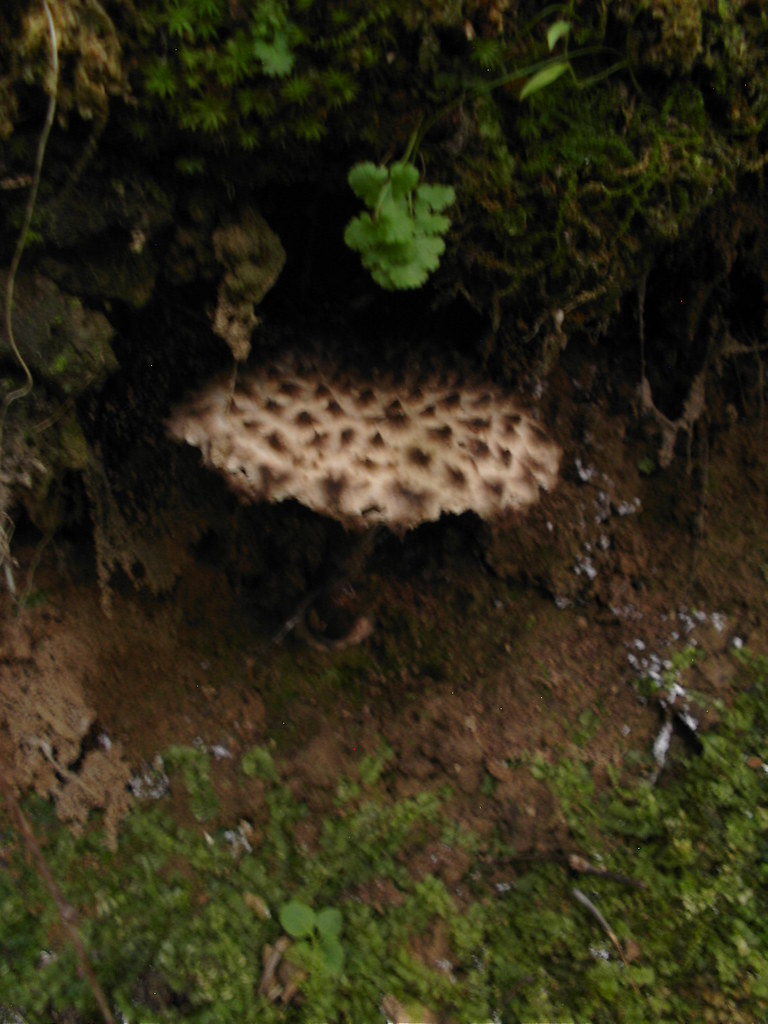
 Here is a small coral mushroom starting out. Although there are some poisonous species none are known to grow in Missouri and many people enjoy eating these easily identifiable fungi.
Here is a small coral mushroom starting out. Although there are some poisonous species none are known to grow in Missouri and many people enjoy eating these easily identifiable fungi. Here is a cool earthstar. I do not see these much because you really have to be looking to see them I was lucky to stumble across this one while picking chanterelles.
Here is a cool earthstar. I do not see these much because you really have to be looking to see them I was lucky to stumble across this one while picking chanterelles.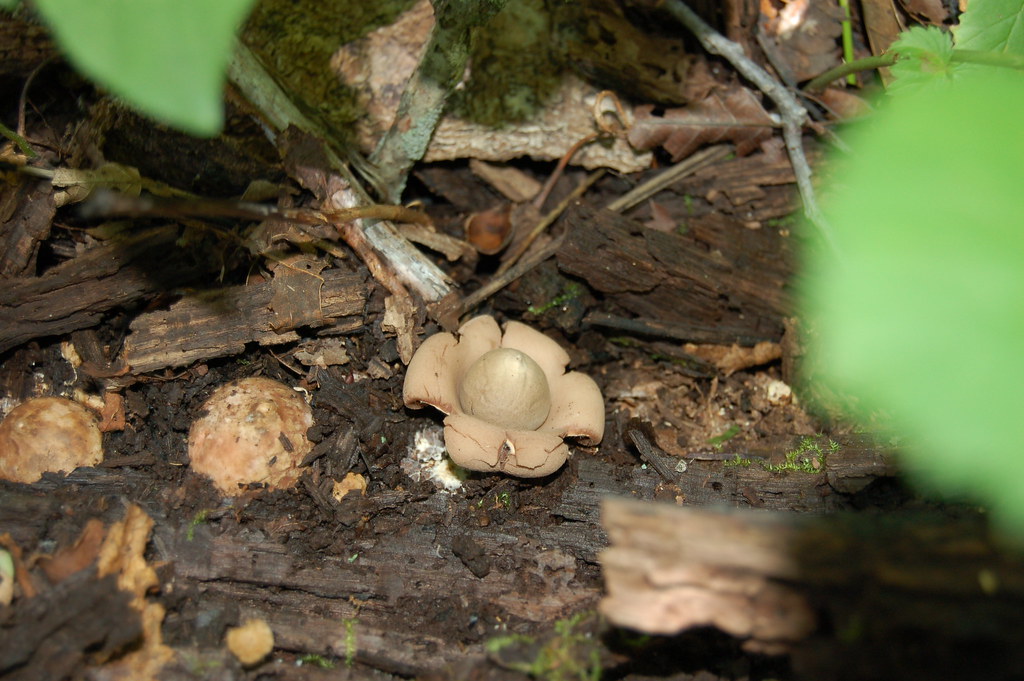
Sunday, July 08, 2007
 Went out to a completely new area today and picked over 15 pounds in about an hour and there were loads more out there. These were all smooth chanterelles and were found in mixed hardwoods (mainly hickory and oaks) around a small lake.
Went out to a completely new area today and picked over 15 pounds in about an hour and there were loads more out there. These were all smooth chanterelles and were found in mixed hardwoods (mainly hickory and oaks) around a small lake.Here is a nice close up showing a top and a glimpse of the slight ridges on the underside of these smooth chants.
They were everywhere even growing right on the trail in glorious patches. I couldn't believe my luck. If anyone wants to find some, contact me at ahistory (at) centurytel (dot) net. I will tell you where to go in Boone County to find some. I could go back there for a week and not be able to pick them all. Conditions I guess were perfect.
Monday, July 02, 2007

July officially begins the start of what looks to be a promising chanterelle season. I went out to check some patches last week and picked about a pound and a half in ten minutes. Hopefully all the rain we have had will help the smaller ones I left behind get bigger (though I haven't had as much luck with chants growing as I have with morels).
Here is another picture of some smooth chanterelles picked last week.
 I have yet to find any common yellow chanterelles or cinnabars but I bet they are up now due to the weekend deluge.
I have yet to find any common yellow chanterelles or cinnabars but I bet they are up now due to the weekend deluge.My computer has been acting up so I have not been able to post for a while. I will try to post more often now that my computer is back up and running (for now).
An elusive one for me up until this year was the black chanterelle or "black trumpet" mushroom (Craterellus cornucopiodes). I found these for the first time early in June. The bigger ones had dried out already and the fresh ones were very small due to the lack of rain back then. I will have to go back and check them again, and now I know where to look. The ones I found were in a draw in between fields near the tops of a slopes. There was little ground cover and leaves but lots of moss. Trees were mainly oak and other mixed hardwoods (hickory, ash, etc).
 Here is the first one I spotted. They are very easy to miss and usually the ones in full moss stand out best.
Here is the first one I spotted. They are very easy to miss and usually the ones in full moss stand out best.
Here is a close up of a small tiny cluster that might have had a chance if it had rained in the five days prior. You can see some larger dried up clusters in the upper right (out of focus).
I hope to find some common yellow chanterelles after all this rain so hopefully I will get some good pics of those for the blog.
Sunday, June 03, 2007


The fronds can be prepared in many ways. In older specimens, only use the softer outer edges. Always cook this mushroom and never eat it raw. Also some people have an adverse allergic reaction to it, so when trying it only eat a little bit and then wait for an hour or so. If no adverse side effects (hives, etc) you should be good to go. Remember though always eat mushrooms in moderation. Eating too much of any mushroom (even morels) can be unpleasant.
For more specific information and additional pictures on the chicken of the woods check out:
http://www.mushroomexpert.com/laetiporus_sulphureus.html
and http://www.michiganmorels.com/beyond_the_morel/chickenofthewoods.html
For some good information on preparing and cleaning see this Hormel (of all places) glossary:
http://www.hormel.com/kitchen/glossary.asp?id=38170
Here are a couple recipes I have found and found to be very tasty.
POLYPORE OMELET
3 Tablespoons butter
1 cup diced Chicken of the Woods
1/4 cup shredded Monterey Jack or cream cheese
2 or 3 shallots, diced
1 Tablespoon chopped fresh parsley
5 or 6 eggs
1/2 cup cream or half and half
Salt and pepper
- Melt the butter in a heavy frying pan over low heat.
- Beat the eggs and cream, add salt and pepper to taste; pour into the pan.
- As the eggs start to cook, sprinkle the Chicken of the Woods, cheese, shallots and parsley over the top.
- Cook for 1 to 2 minutes more until the egg mixture sets.
- Fold the omelet over and remove from the heat; cover and let sit for 1 minute.
Chicken-of-the-Woods Wild Rice
The wild rice harvest is well-managed in our state, so please seek out authentic wild rice for this meal-the flavor and texture is superior to cultivated varieties. (See Resources below. See also "Wild About Ricing," July-August 2004 Conservation Volunteer.)
Chicken-of-the-woods*, also known as sulfur-shelf, is a fall-fruiting, wood-decaying fungus common to Minnesota deciduous and pine forests. Growing on both live and dead wood, this species is a lethal tree pathogen that infects trees with brown rot. However, it is edible.
As with any new food--especially a wild mushroom--wisely introduce only a small portion to your diet. Most important of all, always eat chicken-of-the-woods well-cooked, never raw. Although there is no replacement for the chickenlike texture and bright color of this wild mushroom, you may substitute another mushroom, fresh or dried and reconstituted.
2 shallots, finely minced
1/4 c. butter
2 c. chicken-of-the-woods -mushrooms, cleaned and diced
1 c. hand-harvested wild rice, raw
4 c. chicken stock
salt and pepper
1/4 c. flat parsley, finely minced
In a 5-quart pan, briefly saute shallots in 2 T. butter over medium-high heat until translucent. Add mushrooms and saute for 10 minutes. In a 4-quart saucepan, melt remaining butter, add wild rice, and saute for 5 minutes. Combine with mushroom mixture and chicken stock. Add salt and pepper to taste. Cover and bring to boil over high heat. Reduce heat to low and simmer for 20 minutes. Uncover, fluff rice, add parsley, and if necessary continue heating on low to evaporate any remaining liquid.
*Information here is not complete for safe identification. Never collect wild mushrooms without expert knowledge.
(Recipe from Minnesota Meals of the Present: Recipes)Thursday, May 31, 2007
The chanterelles should be showing up in Mid-Missouri in June, usually closer to the end of the month. And as long as it stays moist, they can flush all the way through September in a good season. I find them in mixed hardwoods with lots of oak and hickory. I have noticed no particular associations with trees, but I do tend to find them along low lying dried up creeks and drainages more often then not. If you find one large patch along a stream continue walking down to where any runoff might have settled and you can usually find more patches down stream. To help the novice hunter I thought I would post a few photos from the last few years to differentiate them from their poisonous look-a-likes, the jack-o-lantern mushroom.
Here is a photo of a lone Jack-o-lantern mushroom taken by a friend. Compared to the previous picture It is easy to see how this could be mistaken for a chanterelle. However, if you look close you can see the gills underneath on the Jack-o-lantern. The gills often run down the stem as pictured here.

The undersides of the smooth chant are, well, smooth, hence the name, and easily distinguished from those of the Jack-o-lantern. Chants also have a fruity, almost apricot, sweet smell to them that Jacks do not.

And Jacks grow from rotten/rotting wood. Sometimes this can be old decaying tree roots underground, so always be careful and look close for any buried wood.
Here are some clusters of Jack-o-lanters that I found in the fall of 2005. Notice on the big one how straight the gills are. Chanterelles do not have gills and the ridges often fork or form a "y" pattern. Jack-o-lanters gills do NOT fork.

This photo shows another distinguishing feature of Jacks. They usually grow in large clusters. Chanterelles on the other hand, tend to grow in patches of singles, doubles and triples. I have yet to find a larger cluster of chanterelles.

Here is a group of common yellow chanterelles. Notice they are not so clustered together.
Good luck and please report any of your finds. Always remeber to follow the mushroom hunter's crede "When in doubt, throw it out."
Thursday, May 03, 2007
Well the season is about over here and unless you want to travel north it's time to take a break from the woods. Don't get me wrong, I am not saying that there are no longer morels out there. I am sure there are a few still in good shape. However, they are few and far between and the warmer weather and recents rains have made the undergrowth come to life making the mushrooms hard to see. Not to mention the ticks. In my opinion it is just not worth the trouble this late in the season.
All in all I had a good season again this year, finding just under 1,000 total. I definately found more before the freeze than after by numbers, but probably an equal amount by weight since the late season ones were nice and plump. I will post a few pictures of some nice late season morels soon.
I use some common flowers to determine when to start and stop hunting and these have been pretty good determiners for me. I start the season when the dandelions in my yard bloom and I end the season when the blackberry bushes bloom. I am not sure why, but they seem to be good indicators for my area.
Now don't think you need to wait until next year. There are many other very tasty and easily recognizable mushrooms out there. And since few Mid-MO locals hunt them like they do morels, the only competition are bugs, turtles and deer. (and yes you have to be pretty slow to get beaten out by a turtle, but it has happened to me before).
The MO Department of Conservation has a good website discussing common poisonous and edible mushrooms in MO. I recommend first learning to identify the poisonous mushrooms before moving on to the edibles. Always follow the mushroom hunters rule: WHEN IN DOUBT THROW IT OUT. THere are old hunters and there are bold hunters, but there are no old and bold hunters.
As far as taste goes, I recommend oyster mushrooms when they are in their very fresh button stage. They can generally be found on old elm trees and logs for a few days after a good rain. Other mushrooms that rival morels in taste are the king bolete or porcini, the hen of the woods or maitake, and the chicken of the woods or sulpher shelf. I think the king is the hardest of all to find in Missouri. If you hunt Kings and have any tips, please send them my way. Maitake generally grow at the bottom of oaks and are really good while they are young. They can be chewy when they get older and long in the pore. Chicken of the woods are easily recognizable from their bright orange and yellow. they are usually found on rotting logs but can also be found growing out of cracks and scars in living trees (largely oak). Another tasty mushroom not included on the MDC site are hedgehog or sweet tooths. These are easily identify by the tiny teeth hanging down from the underside instead of gills or pores.
And my favortie mushroom of all (yes that's right morels are not the best tasting mushroom in my humble opinion) is the chanterelle, several varieties of which usually begin emerging in early June. I have found common yellow chants, smooth (orange) chants, and cinnabar (red) chants in many oak hardwood forests in my area. They smell fruity with a light apricot scent when fresh and can be found growing in patches ranging from just a few to incredible numbers. Last year I was hiking in July and found an old dried up patch of smooth chants that must have had over 1,000 mushrooms in a 60 square foot area. I can't wait to go back to it this year. That's another good thing about many summer and fall mushrooms. they tend to grow in the exact same place, so after a few years you go from mushroom hunting to mushroom picking.
If anyone would be interested in summer and fall mushroom hunting please feel free to contact me. I always welcome company and with the abundance of mushrooms there is always plenty to share.
Wednesday, April 25, 2007
Eating Morels in December – How to Preserve Your Bounty
If you are lucky enough to find more morels this season than you can manage to eat, there are many ways to preserve them for eating later. The most common way is to dry them. You can do this by stringing them up in a warm dry area for a few days or using a standard dehydrator. Some have used microwaves and conventional ovens to dry morels, but this is not recommended as it can be quite tricky leaving little room for error. Even the slightest mistake can lead to a ruined batch of mushrooms and disappointment. I dry mine and then store them in mason jars, but any airtight container will do. If you plan to store them for a while, I recommend going the extra step and storing the jars in the freezer. I have eaten dried morels stored in the freezer up to three years from picking and they were just as good as the first year. Make sure the container is airtight to avoid freezer burn.
Dried morels are great for cooking and once rehydrated can be used in any recipe. Remember to always rehydrate them for at least 3 hours though overnight is more preferable. Also, squeeze out a bit of the liquid before cooking. I often add dried morels directly to slow cooking soups and stews and let them rehydrate as they cook. If you need to rehydrate them faster, simmer them over low heat in liquid for about 15 minutes. They will be a little chewier than if you let them soak, but they are still good. You can also grind up dried morels into a great mushroom powder that adds wonderful richness and depth to sauces and omelets. I do not recommend trying to rehydrate and bread and fry dried morels. Although this works and is tasty, it usually results in crunchy chewy morels.
I use a different method of preservation for ensuring that I have good fried morels all year. This takes a lot more prep work but you get everything out of the way. First, clean the morels and prepare as if you were going to fry them. Slice in half and batter them however you normally do. I only use flour, salt and pepper to cover mine, but I’d bet this with work well for those who use an egg batter and crackers.
Next fry them in butter/oil over medium heat (preferably in an iron skillet) like you normally would but for ONLY 3-4 minutes per side. Take them out and place them on a large cookie sheet covered with wax paper. Once covered, place the cookie sheet in the freezer. After an hour or so, you can remove them from the cookie sheets using the wax paper when they get stuck and store them. I prefer to use large mason jars over freezer bags because they keep a little longer and don't get broken as easily, though Ziplocks will work fine storing them for up to a year. Because they were individually frozen on the sheets the morels shouldn’t stick together in the bags/jars.
When you want to eat some, prepare your butter/oil and take them straight from the freezer and fry them over medium for about 4 minutes on each side until they are golden brown. This year I did a family/friend taste test where I fried up some fresh ones I had just found and some frozen ones I had left over from the ones I prepared last spring. Only one person out of four was able to consistently tell me which they were eating. They said they only noticed a slight difference in texture. I myself could not really tell a difference, they were all just as good in my book.
Monday, April 23, 2007
Here's the link to the article in the Missouri Conservationist: The Wild Morels
Here is another state web page on morels: Missouri's Magnificent Munchable Morels
 Here is a picture of a yellow I found today. Only found ten but they were big. All of the ones I found had fallen over and were laying on their sides.
Here is a picture of a yellow I found today. Only found ten but they were big. All of the ones I found had fallen over and were laying on their sides.
I am new to blogging so bear with me as I begin to expand this site. I hope to put up some useful information and document some of my own hunting experiences this year and in the future. Hopefully the information will become useful to some of you.
I will start off with a brief diary of my 2007 morel hunting season which is still going strong. I have found over 800 so far and as the season winds down in the river bottoms I am beginning to check spots in the hills. More to come real soon.
I welcome all mushroom hunters and anyone who loves walking the woods. Please feel free to leave a comment with any suggestions for the site.






